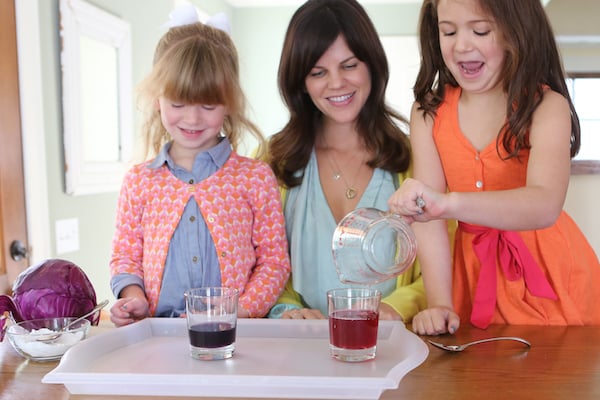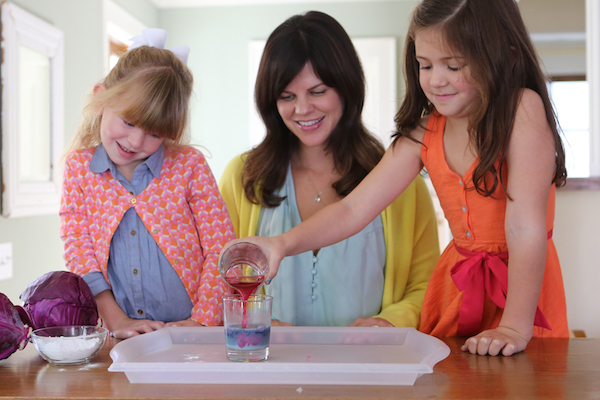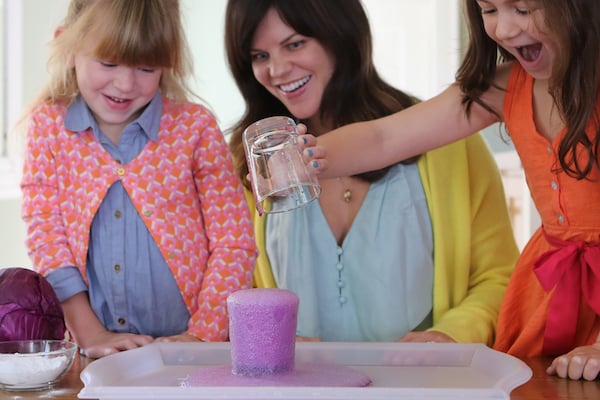Editor's note: This post was originally published on May 13, 2016.
Scientists use litmus paper to test the pH of solutions in their labs, but it’s tons of fun to create your own acid/base indicator at home with your child. Make these indicators to observe color-changing, foaming chemical reactions!
If you boil red cabbage in water, you’re left with purple juice that turns pink in acids and blue (or green) in basic solutions. This happens because a change in pH changes the shape of the pigments (molecules that give things color) in the cabbage juice, causing them to absorb light differently.
If you add baking soda to one cup of cabbage juice, and vinegar to a second cup of cabbage juice, you’ll end up with one pink cup and one blue cup.

A chemical reaction occurs when you mix things together and make something new. Pour the pink solution into the blue solution and you’ll create a chemical reaction that makes carbon dioxide gas. The potion will bubble over and turn purple again, as if by magic!

Ingredients & Supplies Needed:
To do this experiment, you’ll need: a head of red cabbage, baking soda, vinegar, a tray or cookie sheet, and some clear cups or containers.
Experiment Steps:
-
Chop a head of red cabbage into small pieces and add it to a pan with enough water to cover it. Boil the cabbage uncovered for about 15 minutes, stirring occasionally, let it cool, and strain the juice into a jar or bowl. (To avoid the stove, chop half a head of red cabbage and blend it with about 3 cups of water. Strain the liquid through a colander and then through a coffee filter in a plastic bag with one corner cut off.)
-
Pour about 1/4 cup of the cabbage juice, or “magic potion” into 2 clear glasses or bowls and set them on a white piece of paper (so you can watch the color change).
-
Tell your child that the juice will turn blue in a base (they both start with the letter B, which may help them remember) and pink in an acid.
-
Ask them whether they think baking soda is an acid or a base. Then let them test their hypothesis (guess) by adding 1 tablespoon of baking soda to one glass of potion. What happens?
-
Now ask whether they think vinegar is an acid or a base. Add at least 3 tablespoons of vinegar to the second cup of potion. It should turn bright pink.
-
Remind your child that a chemical reaction is simply mixing some things together to make something new. Tell them that the new thing you make when you mix baking soda and vinegar together is carbon dioxide gas.
-
Place the blue cup onto a tray or cookie sheet. Have them pour the pink (vinegar) solution into the blue (baking soda) solution. If you don’t get lots of bubbles, try it again, but add more vinegar to the pink solution.
- Let your child try the experiment again their own, playing with different amounts of everything. Have them draw their experiment or record their results in a homemade lab notebook.

More about the science behind the fun:
Everything in our world is made of incredibly tiny pieces called atoms. Atoms are often connected to other atoms to form linked groups called molecules.
Molecules that give things color are called pigments. The pigment molecules in purple cabbage juice are shape-shifters and change color when they change shape. When you put them in acids, like vinegar, they turn red or pink, but when you mix them with a base like baking soda, they turn blue or green.
Mixing vinegar potion and baking soda potion together creates a chemical reaction that can make enough carbon dioxide gas bubbles to overflow your cup!
Try adding some other liquids to your magic potion. Can you tell whether they are acids or bases?
Enrichment activity:
To make litmus paper, soak white coffee filters in red cabbage juice, dry, soak again and let dry. Cut the filters into strips and use them to test things like dish soap, lemon juice and other safe kitchen chemicals to see whether they’re acids or bases.
See it in action:
Watch a video of this experimient here.
You can find more experiments like this one at kitchenpantryscientist.com, and in my books Kitchen Science Lab for Kids (Quarry Books), and Outdoor Science Lab for Kids (Quarry Books).
© Quarry Books, 2016
Featured Photos Credit: © Amber Procaccini

